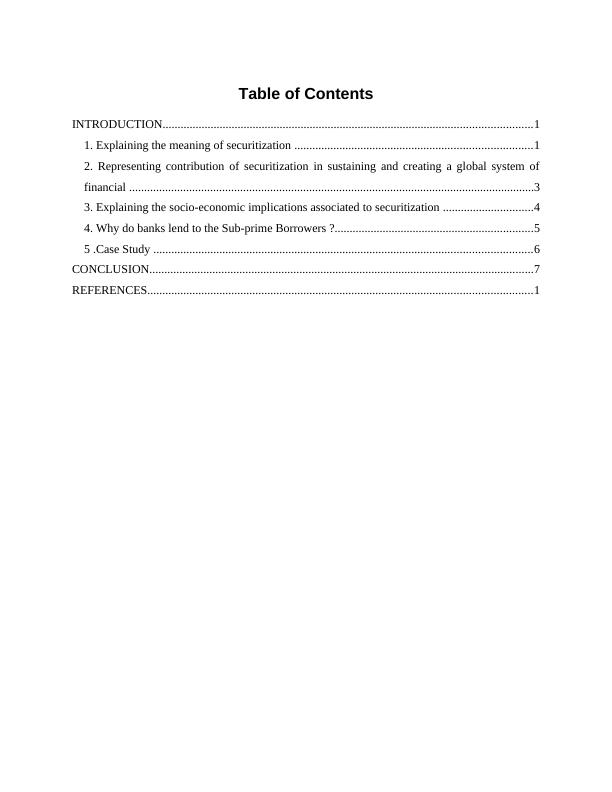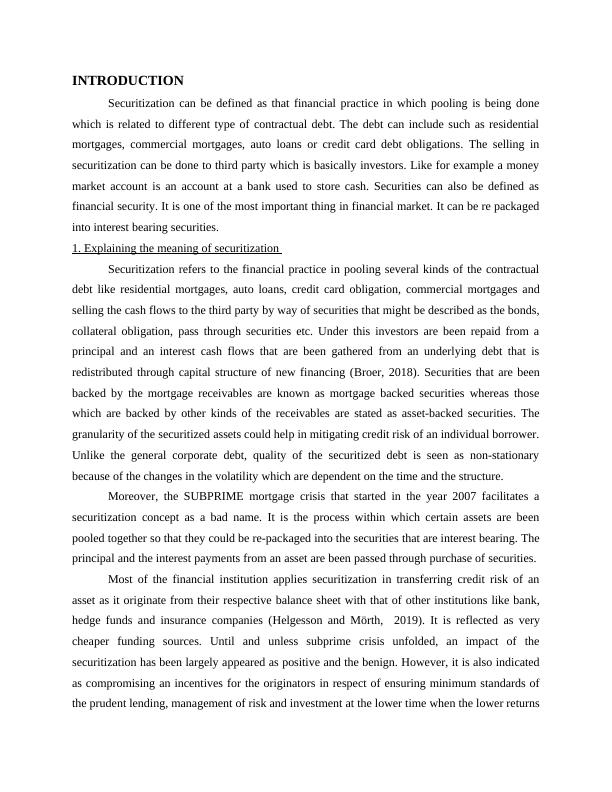Securitization: Explaining Meaning, Contribution, and Socio-Economic Implications
Added on 2023-01-16
12 Pages3631 Words28 Views
SECURITIZATION

Table of Contents
INTRODUCTION...........................................................................................................................1
1. Explaining the meaning of securitization ...............................................................................1
2. Representing contribution of securitization in sustaining and creating a global system of
financial .......................................................................................................................................3
3. Explaining the socio-economic implications associated to securitization ..............................4
4. Why do banks lend to the Sub-prime Borrowers ?..................................................................5
5 .Case Study ..............................................................................................................................6
CONCLUSION................................................................................................................................7
REFERENCES................................................................................................................................1
INTRODUCTION...........................................................................................................................1
1. Explaining the meaning of securitization ...............................................................................1
2. Representing contribution of securitization in sustaining and creating a global system of
financial .......................................................................................................................................3
3. Explaining the socio-economic implications associated to securitization ..............................4
4. Why do banks lend to the Sub-prime Borrowers ?..................................................................5
5 .Case Study ..............................................................................................................................6
CONCLUSION................................................................................................................................7
REFERENCES................................................................................................................................1

INTRODUCTION
Securitization can be defined as that financial practice in which pooling is being done
which is related to different type of contractual debt. The debt can include such as residential
mortgages, commercial mortgages, auto loans or credit card debt obligations. The selling in
securitization can be done to third party which is basically investors. Like for example a money
market account is an account at a bank used to store cash. Securities can also be defined as
financial security. It is one of the most important thing in financial market. It can be re packaged
into interest bearing securities.
1. Explaining the meaning of securitization
Securitization refers to the financial practice in pooling several kinds of the contractual
debt like residential mortgages, auto loans, credit card obligation, commercial mortgages and
selling the cash flows to the third party by way of securities that might be described as the bonds,
collateral obligation, pass through securities etc. Under this investors are been repaid from a
principal and an interest cash flows that are been gathered from an underlying debt that is
redistributed through capital structure of new financing (Broer, 2018). Securities that are been
backed by the mortgage receivables are known as mortgage backed securities whereas those
which are backed by other kinds of the receivables are stated as asset-backed securities. The
granularity of the securitized assets could help in mitigating credit risk of an individual borrower.
Unlike the general corporate debt, quality of the securitized debt is seen as non-stationary
because of the changes in the volatility which are dependent on the time and the structure.
Moreover, the SUBPRIME mortgage crisis that started in the year 2007 facilitates a
securitization concept as a bad name. It is the process within which certain assets are been
pooled together so that they could be re-packaged into the securities that are interest bearing. The
principal and the interest payments from an asset are been passed through purchase of securities.
Most of the financial institution applies securitization in transferring credit risk of an
asset as it originate from their respective balance sheet with that of other institutions like bank,
hedge funds and insurance companies (Helgesson and Mörth, 2019). It is reflected as very
cheaper funding sources. Until and unless subprime crisis unfolded, an impact of the
securitization has been largely appeared as positive and the benign. However, it is also indicated
as compromising an incentives for the originators in respect of ensuring minimum standards of
the prudent lending, management of risk and investment at the lower time when the lower returns
Securitization can be defined as that financial practice in which pooling is being done
which is related to different type of contractual debt. The debt can include such as residential
mortgages, commercial mortgages, auto loans or credit card debt obligations. The selling in
securitization can be done to third party which is basically investors. Like for example a money
market account is an account at a bank used to store cash. Securities can also be defined as
financial security. It is one of the most important thing in financial market. It can be re packaged
into interest bearing securities.
1. Explaining the meaning of securitization
Securitization refers to the financial practice in pooling several kinds of the contractual
debt like residential mortgages, auto loans, credit card obligation, commercial mortgages and
selling the cash flows to the third party by way of securities that might be described as the bonds,
collateral obligation, pass through securities etc. Under this investors are been repaid from a
principal and an interest cash flows that are been gathered from an underlying debt that is
redistributed through capital structure of new financing (Broer, 2018). Securities that are been
backed by the mortgage receivables are known as mortgage backed securities whereas those
which are backed by other kinds of the receivables are stated as asset-backed securities. The
granularity of the securitized assets could help in mitigating credit risk of an individual borrower.
Unlike the general corporate debt, quality of the securitized debt is seen as non-stationary
because of the changes in the volatility which are dependent on the time and the structure.
Moreover, the SUBPRIME mortgage crisis that started in the year 2007 facilitates a
securitization concept as a bad name. It is the process within which certain assets are been
pooled together so that they could be re-packaged into the securities that are interest bearing. The
principal and the interest payments from an asset are been passed through purchase of securities.
Most of the financial institution applies securitization in transferring credit risk of an
asset as it originate from their respective balance sheet with that of other institutions like bank,
hedge funds and insurance companies (Helgesson and Mörth, 2019). It is reflected as very
cheaper funding sources. Until and unless subprime crisis unfolded, an impact of the
securitization has been largely appeared as positive and the benign. However, it is also indicated
as compromising an incentives for the originators in respect of ensuring minimum standards of
the prudent lending, management of risk and investment at the lower time when the lower returns

on the conventional products, default rates resulted below historical experiences (Mordel and
TeNyenhuis, 2018). Wide availability of the hedging tools were been encouraging an investors in
taking the more and more risk in achieving higher yield.
2
TeNyenhuis, 2018). Wide availability of the hedging tools were been encouraging an investors in
taking the more and more risk in achieving higher yield.
2

End of preview
Want to access all the pages? Upload your documents or become a member.
Related Documents
Impact of Securitization on Canadian Financial Market and Global Financial Crisislg...
|6
|1596
|202
Corporate Financelg...
|11
|1966
|228
Benefits and Risks of Securitization in Financial Analysislg...
|7
|1477
|125
Asset Securitization in Banking and Finance: Benefits, Risks, and Financial Criseslg...
|3
|610
|489
Subprime Credit Crisis: Risk Managementlg...
|8
|2360
|22
2008 Financial and Economic Crisis | Reportlg...
|9
|1913
|20